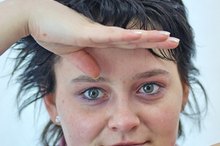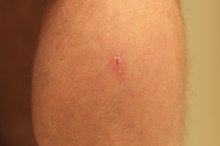What does fact checked mean?
At Healthfully, we strive to deliver objective content that is accurate and up-to-date. Our team periodically reviews articles in order to ensure content quality. The sources cited below consist of evidence from peer-reviewed journals, prominent medical organizations, academic associations, and government data.
The information contained on this site is for informational purposes only, and should not be used as a substitute for the advice of a professional health care provider. Please check with the appropriate physician regarding health questions and concerns. Although we strive to deliver accurate and up-to-date information, no guarantee to that effect is made.
How to Get Rid of Ice Pick Acne Scars
Acne is an embarrassing skin issue. However, it becomes even more embarrassing when the blemishes cause scarring. Ice pick scars are common, according to Acne.org, and described as deep pits 2 mm or less in length. The scarring got its name because the skin appears to have small puncture marks. Fortunately, there are treatments effective at getting rid of ice pick acne scars.
Treat acne before starting scar treatment 1. A dermatologist will use topical treatments, such as adapalene or tretinoin to heal acne. If acne doesn’t respond, she will try antibiotics in conjunction with topical treatments. For the most serious cases of acne, a doctor may prescribe isotretinoin, an oral medication, to get rid of acne. However, this medication can’t be taken while pregnant and side effects are very serious.
How to Remove an Indented Scar
Learn More
Laser CO2 treatments 1. This treatment uses a laser that removes the top layer of the skin. Laser treatments are very effective because the depth of penetration is more easily controlled than with other options. A dermatologist will pass the laser over the skin up to three times. The sessions lasts up to an hour, depending on the severity of acne. Cost for treatment is up to $6,000 and may need to be repeated after six months.
Er: YAG laser treatments 1. This is another type of laser resurfacing treatment. This option achieves the same results as other laser treatments and promotes new skin growth. However, side effects are milder than the CO2 treatment and healing time is quicker. The cost is up to $6,000 and treatment may need to be repeated after six months.
How to Remove Holes Caused by Acne Scars
Learn More
Fractional laser. The fractional laser resurfaces scar sites more gently. This treatment is appropriate for less severe ice pick scars. Results aren’t as impressive as the CO2 or Er:Yag laser treatments, but side effects are milder. Cost is $1,000 per session. Typically four to five sessions are required.
Consider skin needling treatment 1. This treatment uses a needle tool to cause tiny punctures on the acne site 1. When the area starts to heal new collagen will grow, reducing the appearance of scarring. The cost for treatment is $150 to $500 for each session. Typically, one to two sessions are required before results are experienced.
Tips
Each treatment option has different side effects. Talk with your doctor about each potential side effect before selecting a treatment option.
Warnings
Insurance companies don’t usually cover these treatments. Talk with your insurance company before choosing a treatment option.
Related Articles
References
- Acne.org: Acne Scar Treatment
- MayoClinic.com: Acne
- Medline Plus: Acne
- "Questions and Answers About Acne." National Institute of Arthritis and Musculoskeletal and Skin Diseases (NIAMS). Jan 2006. National Institutes of Health.
- Zaenglein AL, Pathy AL, Schlosser BJ, Alikhan A, Baldwin HE, et. al. "Guidelines of Care for the Management of Acne Vulgaris." Journal of the American Academy of Dermatology. 2016;74(5):945-73.
Writer Bio
Nicki Howell started her professional writing career in 2002, specializing in areas such as health, fitness and personal finance. She has been published at health care websites, such as HealthTree, and is a ghostwriter for a variety of small health care organizations. She earned a Bachelor of Science in business administration from Portland State University.









